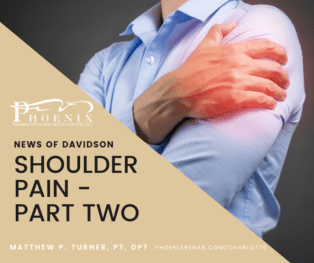FITNESS AND WELLNESS
Shoulder Pain – Part 2

So now that we know the basic anatomy of what makes up the shoulder complex, we can go into a little detail regarding common injuries and pathologies you may have heard of. As mentioned in “Part 1,” the shoulder complex is an intricate and involved system of joints, muscles, ligaments, and fascia – which makes individual, specific diagnoses rather difficult to state with 100% accuracy.
Two of the most common pathologies and diagnoses that we see every day in the clinic are “rotator cuff tendinopathy” and “shoulder impingement.”
Rotator Cuff Tendinopathy
Probably the most common diagnosis we are presented with in the clinic is rotator cuff tendinopathy. An injury to the rotator cuff can occur as a simple overuse injury where the tissues get overworked and become inflamed and highly sensitive, but it can also occur with sudden lifting actions that overload the tissue. If you’re a professional sports fan, you will constantly hear of football players (quarterbacks especially) having to undergo “shoulder debridement” surgery – this is, in its most basic form, a cleaning up of some frayed rotator cuff tissue to help with pain and function.
When a tendon of a muscle (something that connects muscle to bone to allow for movement) becomes irritated, initially you will usually experience what’s known as “tendonitis,” “-itis” refers to the active inflammatory process occurring within the body to promote natural healing and can occur in other areas such as the bursa (bursitis). If the inflammatory process continues for too long, the warmth, swelling, and oftentimes pain can stop being beneficial and actually result in tissue damage and decreased recovery. This, then, becomes known as “tendinopathy.”
The inflammatory process occurs for roughly 0-10 days, depending on the tissue involved, and is consistent with complaints, such as warmth, redness, achiness/pain, and swelling of the area. This is the body’s natural recovery system as it brings in fluid that is rich in nutrients, chemicals, and white blood cells to help repair the injured tissue. With prolonged inactivity or too much swelling, more chronic changes can occur that result in further weakness of the tissue, as well as potential increase in pain and poorer outcomes.
A recently published article found that not only does the prevalence of rotator cuff tears increase with age (the older you get the greater chance of having a rotator cuff tear), but that the prevalence of full-thickness, asymptomatic (no pain or functional loss reported) occurred with over 14% of the population. Another report actually found that in 96% of participant MRI’s who did not have any symptoms (pain, range of motion or functional loss), those same patients had, at least, one pathological finding on their report despite the lack of functional loss!
What this tells us is that just because your MRI may indicate you have a rotator cuff tear or pathology, this does not necessarily mean you should expect pain, functional loss, or ultimately need surgery. There are obvious exceptions to the rule, but we won’t go into that in this blog post.
Shoulder Impingement
Impingement syndrome is a generic, non-specific term for pain throughout the shoulder caused by overcrowding and inflammation of the rotator cuff muscles as they run through the subacromial space. Impingement is often synonymous with rotator cuff tendinopathy due to the supraspinatus muscle often being the cause of the pain and dysfunction.

As you can see in the image below, there is a space between the acromion bone of your shoulder blade, and the supraspinatus muscle that sits on the top of your shoulder blade. When you raise your arm, the space between the muscle and bone decreases, and if your rotator cuff is weak or inflamed/sensitive, can cause pain at the site of the impingement or radiate into your shoulder and arm.
Don’t be alarmed though, whenever we raise our arms, we are continually ‘impinging’ our rotator cuff muscles. This fact alone should decrease some fears when we hear the diagnosis of “shoulder impingement,” as it is yet another example of an everyday occurrence that happens with everyone. The difference, and what sometimes causes issues, is when the tissues become inflamed and sensitive, or there is bone growth that limits the space even more – causing more irritation and sensitivity of the structures.
With adequate activity modification and conservative care, including Physical Therapy, Chiropractic care, and/or Massage Therapy, there’s a good chance these symptoms can be addressed without surgery or prolonged use of medications. By strengthening the rotator cuff and shoulder blade stabilizers, we are able to improve the mechanical advantage of the muscles, which decreases the pressure and irritation of underlying tissues that allows for recovery to occur.
Next blog post we will focus on some less common injuries to the shoulder complex!
Matthew Turner
A native of Sheffield, England, Matthew Turner moved to North Carolina in 2016, with his wife Rachael, and has worked in an outpatient orthopedic setting, specializing in manual therapy. Matt is the Facility Director and lead physical therapist for the PHOENIX Rehabilitation and Health Services, Charlotte location. Matt's clinical expertise focuses on outpatient orthopedics, post-operative conditions, concussion, and sports/work-related injuries. Matt underwent post-graduate training with NAIOMT and is a Certified Manual Physical Therapist. He is also certified in Dry Needling and Blood Flow Restriction Training.


